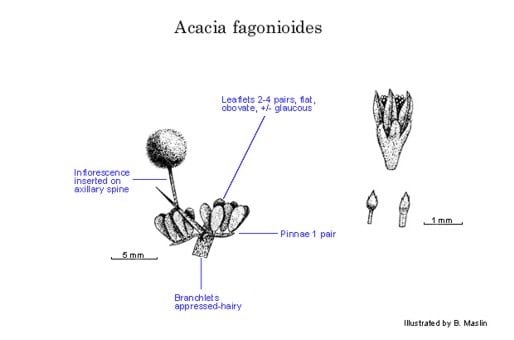Acacia fagonioides Benth.
WATTLE
Acacias of Australia
Family
Fabaceae
Distribution
Disjunct, occurring around Eneabba, Cervantes and Toodyay, south-western W.A.
Description
Shrub 0.2–0.5 (–1) m high, intricate. Branchlets appressed-puberulous, sometimes spinose. Axillary spines 1 per node, 3–18 mm long. Leaves sometimes reflexed; pinnae 1 pair, 2–5 mm long; petiole absent; pinnules 2–4 pairs, normally obovate to narrowly oblong-obovate, 2–5 mm long, 1–2 mm wide, glaucous to subglaucous, glabrous to subglabrous; gland within axil of pinnae, stipitate, c. 0.5 mm long. Inflorescences simple, situated on upper half of axillary spine; peduncles 4–8 mm long, appressed-puberulous; heads globular, 13–25-flowered. Flowers 5-merous; sepals 1/2–3/4-united. Pods 3–8 cm long, 7–12 mm wide, slightly pruinose, glabrous. Seeds longitudinal to oblique, sometimes transverse, elliptic to circular, turgid, 3–4 mm long.
Habitat
Grows in sand in heath at Eneabba and in lateritic soil in Marri (Corymbia calophylla) forest at Toodyay.
Specimens
W.A.: W of Toodyay towards Perth, N.T.Burbidge 8034 (PERTH); just S of Arrowsmith R. on Eneabba–Arrino road, 1 July 1973, C.Chapman (AD, B, BRI, CANB, K, L, MEL, NSW, NY, PERTH); Swan R., J.Drummond 2: 154 (?BM, G, G-DC, K, LUND, MEL, NSW, OXF, P, PERTH.
Notes
Acacia fagonioides and A. epacantha are unique within the ‘A. pulchella group’ in having inflorescences borne on axillary spines which commonly have the appearance of short branchlets. Acacia fagonioides is further distinguished from A. pulchella by pods 7–12 mm wide.
FOA Reference
Data derived from Flora of Australia Volumes 11A (2001), 11B (2001) and 12 (1998), products of ABRS, ©Commonwealth of Australia
Author
B.R.Maslin
This identification key and fact sheets are available as a mobile application:
URL: https://apps.lucidcentral.org/wattle/
© Copyright 2018. All rights reserved.







